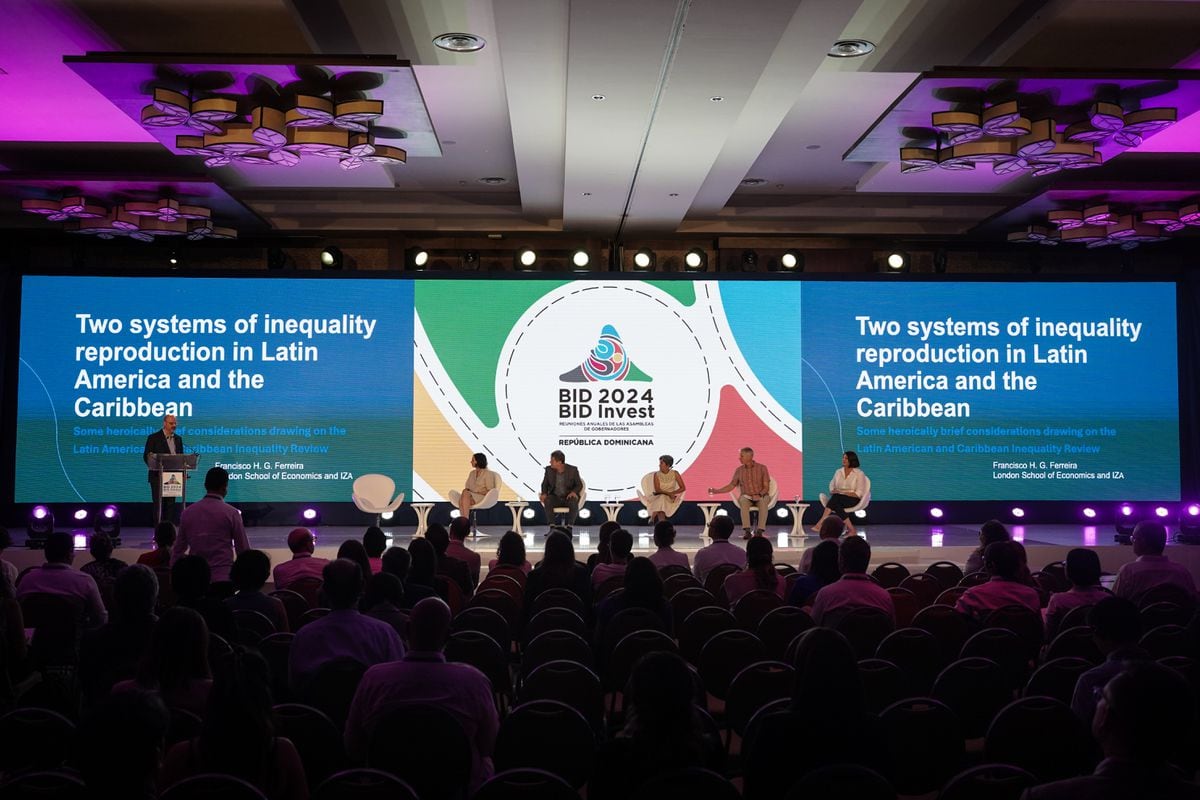EL PAÍS offers the América Futura section open for its daily and global informative contribution on sustainable development.
If you want to support our journalism, subscribe
here
.
Forty-five minutes before riding her folding bicycle the 4.4 kilometers that separate her from her office, Carolina Guevara puts on her makeup.
She dresses formally, like every day, and she carries a small backpack with documents and her personal computer.
Every morning, she pedals for 30 minutes on a long bike path to get to her work in downtown Bogotá.
She does it at a calm pace “counting flowers”, she says, so as not to sweat more than she should, and it takes exactly the same time as the public transport bus.
It is at night when she feels the difference: “When I leave work, if I take a bus it can take me an hour and a half or even more.
On the other hand, by bike, I do the usual 30 minutes and I get home much more relaxed, ”says Carolina, who has used her bicycle to go to and from work for five years.
On her daily trips, Carolina sees hundreds of women and men riding the bike path, and is surprised to learn that in Latin America only a quarter of bicycle trips are made by women.
“I understand that there is a perception of insecurity that can scare women away from cycling, but in areas where there are bike paths, I think things become much more even”, she comments.
For Shila Alvarado, a plastic artist from Lima, Peru, on the other hand, riding a bicycle in her city is a high-risk sport, especially for women.
“I always go on the defensive, because it is not only a matter of taking care of the traffic and the rest of the cyclists, who often drive irresponsibly, but also of the pedestrians, of the drivers and of the cycle paths, many of which are in a unfortunate state," he explains.
According to her account, to these difficulties must be added machismo and prejudice.
"I see a lot of girls riding the bike with huge headphones, and when I ask them, they tell me it's so they don't hear the dirty things they're yelling at," says Shila, who believes that this type of problem discourages more women from riding. to a bicycle.
“They cut our city.
Because you no longer only have to worry about cars and pedestrians, but also about what clothes you are going to wear or what they are going to say to you;
So it happens that many prefer not to use the bike.
It is a mixture of lack of education, machismo and a thousand other things that make one feel powerless”.
While for Carolina, the journeys to and from her office by bicycle represent significant savings in time and money, and a more comfortable and safer option to move around Bogotá, for Shila, the determination to travel by bicycle is a risk that she assumes with some stubbornness and resignation.
Carolina Guevara in Bogota.Diego Cuevas
This divergence of opinions may have to do with the differences of each city and its mobility policy.
On the one hand, Bogotá is, according to the INRIX index, the eighth city in the world with the highest traffic congestion and, at the same time, it is considered the capital of bicycles in Latin America, with more than 600 kilometers of exclusive infrastructure for bicycles and an average of 880,000 daily bicycle trips.
According to the most recent study in Bogotá carried out by the Ministry of Mobility in 2019, women make 34% of daily bicycle trips in the city.
For its part, the capital of Peru has barely 200 kilometers of bike paths, most of which are fragmented and lead nowhere.
In addition, the city does not have an integrated mass public transport system and, according to a 2019 Thomson Reuters Foundation study, Lima is the most insecure metropolis for women in Latin America, and the fifth in the world.
Different realities that show how the cycling culture in the region is disparate and is due to various social and urban factors.
Cycle routes to close the gender gap
For Elizabeth Añaños, an architect and former Vice Minister of Housing and Urban Planning of Peru, the differences between Bogotá and Lima in terms of the maturity of the cycling culture are evident.
“In Bogotá, an integrated mobility system was made and the periphery was prioritized, where the bike path was the main transport.
In Lima, on the other hand, there is no orderly and integrated mass transportation system, nor a cycling infrastructure that connects the city,” says Añaños.
For the architect, beyond the efforts of mayors and authorities of Latin American cities, and emblematic cases such as Bogotá and Santiago de Chile, there are great structural difficulties that prevent the use of the bicycle, promoted for a decade by governments and accelerated by the pandemic, is consolidated as a real mobility option for a large part of the region's population.
“For the bicycle to work in a city, the entire transport system has to work first.
You cannot see a single type of mobility in isolation, because in the journeys they make through the city, a citizen should be able to use different types of transport," explains Añaños, who believes that in Latin American cities there are issues that must be addressed. first to be able to massify the use of the bicycle.
"We are far behind in the construction of public space, which is completely related to mobility," explains the former Peruvian vice minister, who suspects that the large gaps in the use of bicycles between men and women have a lot to do with the available infrastructure and the policies of urban planification.
Bicycles ready for rent in El Virrey park in Bogotá.Diego Cuevas
“Men's travel patterns are commuting, from home to work, from work to home.
Instead, the women's patterns are chained.
From the house to the store, from the store to taking the children, from the children to work, and so on.
More trips, but shorter.
If you imagine those minimal trips in Lima by bicycle, with a dangerous transport system, where you have to take your child or where you have to carry packages, it is very likely that you will not choose the option of a mobility system such as the bicycle , because you have a road infrastructure system that is not complete and that does not adapt to your journeys”, explains Añaños.
The case of Buenos Aires
For Germán Bussi, former secretary of transport planning of the Argentine Republic, the low participation of women in bicycle mobility is associated with the creation of cycling infrastructure.
"When there is still no adequate infrastructure or great development of cycling mobility is not observed, the profile of bicycle users usually comes from the most sporting activity, and this produces a bias towards the younger population and a greater tendency of males.
However, to the extent that the bicycle becomes a mode of urban mobility for daily activities, the profile changes and women and the elderly are incorporated, who are more prudent and have a greater aversion to risk”, says the expert in mobility.
Bussi gives as an example the process that the city of Buenos Aires went through.
“In 2008 we had around 1% of urban trips by bicycle, of which barely 7% were made by women.
Little by little, as the number of cyclists grew, the percentage of women also increased, reaching around 22%.
This means that, although cyclists in the city tripled in just over 10 years, in the case of women this figure grew much more, exponentially.
Along these lines, the average age of cyclists also increased”.
A cyclist circulates on an avenue in Bogotá, on September 22.
VANNESSA JIMENEZ
However, Bussi explains that, although our cities need investment in cycling infrastructure, it must be functional and adapted to the uses of the population.
“Cultural change begins with objective, material changes.
Adapted and professional infrastructure is needed so that at least 80% of the movement of bicycle users is on protected infrastructure.
Unfortunately, in Latin American cities we see a lot of cycling infrastructure built out of commitment or to follow an agenda, but not necessarily with a view that assumes the challenge of taking space from vehicle parking to create a new space that serves for mobility”, says Bussi. .
Although it is clear that the region is far from seeing the bicycle as a means of mass mobility, it is also true that there are important advances in the matter.
According to the 2022 Ipsos Cycling Across the World study, Latin American countries register figures close to the world average of people who use the bicycle as their main means of transport for distances of approximately 2 kilometers (14%).
The study highlights Colombia as the region's leader in this section, with 16%.
They are followed by Argentina and Peru (13%), Chile (12%), Mexico (11%) and Brazil (10%).
Figures that mark a first glimpse of how the bicycle could become a real mobility option in the region.
Meanwhile, Carolina will continue to navigate Bogotá on her folding bike every morning, and Shila will continue to take the necessary precautions so that the voracious Lima and her still-incipient cycling culture don't end up swallowing her up.

/cloudfront-eu-central-1.images.arcpublishing.com/prisa/VROBIXL4JFADTC5QV5GVJTPC2M.jpg)


/cloudfront-eu-central-1.images.arcpublishing.com/prisa/EMYXC3EVHNEG3OJHGIQCB2IVYA.jpg)
/cloudfront-eu-central-1.images.arcpublishing.com/prisa/Q6UJ4IEP6ZGLZLS3MSHF7LNYOU.jpg)
/cloudfront-eu-central-1.images.arcpublishing.com/prisa/ETGSMPG4ZNFJFFLVSLKB3DWPSQ.jpg)
/cloudfront-eu-central-1.images.arcpublishing.com/prisa/2C5HI6YHNFHDLJSBNWHOIAS2AE.jpeg)
/cloudfront-eu-central-1.images.arcpublishing.com/prisa/NYBERFPPHVEJVER4FIRIEAGGX4.jpg)






